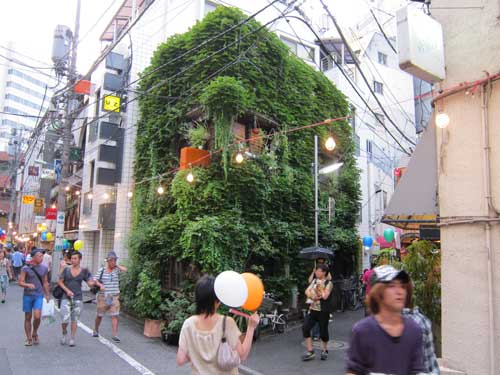
I love how this small building in a Shinjuku commercial district is buried in vines. On a hot summer day, it makes you feel cooler just looking at all those green leaves.

I love how this small building in a Shinjuku commercial district is buried in vines. On a hot summer day, it makes you feel cooler just looking at all those green leaves.

I first saw these vines a month ago on a nearby sidewalk. They are growing in plastic buckets with an elaborate plastic twine trellis supported by a tree branch. Initially I misidentified them as morning glory. Recently, I saw how tall and thick the vines had become, and that they are in fact bitter melon, with vegetables ready to eat. The shop owner saw me taking these photos, and seemed very proud of his summer edible garden on a busy street.

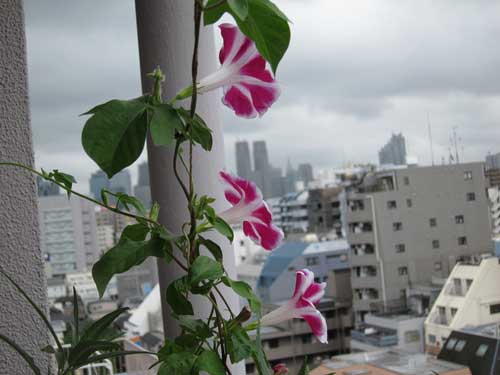
Even though I planted the seeds back in May, it’s only recently that the Edo morning glory vines have climbed up to the top of the balcony and begun blooming. As their name implies, the flowers are most spectacular in the morning. By afternoon, they wilt and are finished. Each day there are about a dozen new flowers.
Last year, I visited the famous Iriya morning glory festival and bought five different colors. Last year I harvested seeds from all the plants (and also bitter melon, chamomile and some that I forgot). It’s interesting that all of my plants, and those I gave to friends, are this red and white variegated variety.
Here you can see that I stored the seeds in sake cups bought from a student at Shiho ceramic studio.
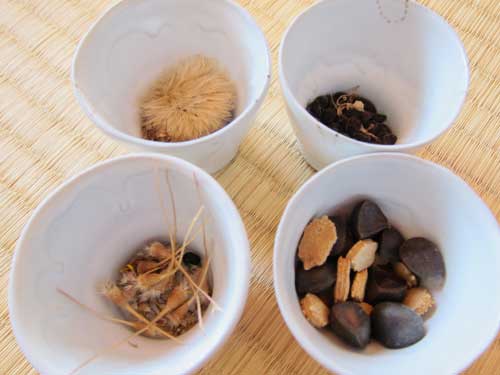
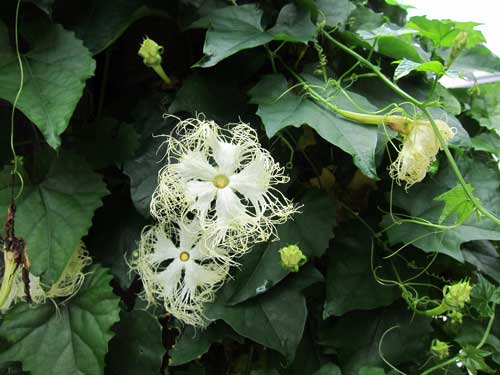
Vines are a perfect city plant: requiring relatively little soil and space, covering large vertical areas, providing seasonal foliage and color. This wispy white passion flower is lovely.
Update: Since Jason informed me that maybe it isn’t a passion flower vine, I have added a second image. Anyone else have an idea what it is? Do you think that gourds/melons/squash are being formed? The added image also shows how the vine both covers that wall between properties and also decorates the side gate.
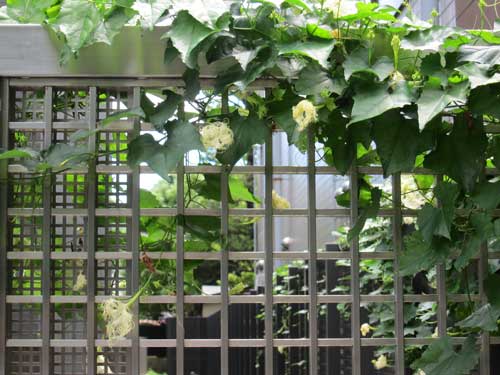

My watermelon plant has produced an enormous amount of growth in just two months on the balcony. It was very easy to train the vines onto the metal rod balcony. Now there are two fruits the size of oranges. I love the shape of the leaves, and am looking forward to having a watermelon party when they are ripe.
There are many previous posts about my balcony garden. It is approximately 1 meter by 6 meters, and includes the air conditioner, washer dryer, clothes line, a small stand, and about 100 plants. In addition to the permanent railing, we recently installed a summer green curtain net for extra shade and cooling.
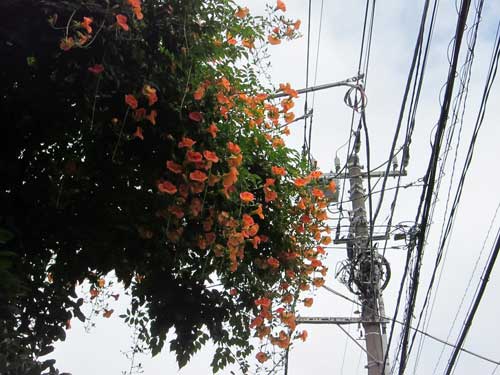
This exuberant, orange flowered vine seems to launch itself off the side of a small two story residence. I love the contrast of the vine with the equally excessive, overhead power lines. The vine is part of the amazing multi-family residential building that is entirely covered in plants, which I included as part of a vertical garden comparison.

I have started to notice all over Tokyo that people are creating makeshift plastic rope trellises for summer morning glory vines. This one near my home is particularly ingenious: the trellis wraps around two blue buckets containing the vines, and the rope is looped over the street tree. A zig-zag pattern is added for extra support.
Is this a new trend? I am looking forward to watching these plants grow this summer.
UPDATE: One month later, the vines cover the trellis, and I realize that it’s bitter melon, not morning glory. The vegetables are ready to eat.

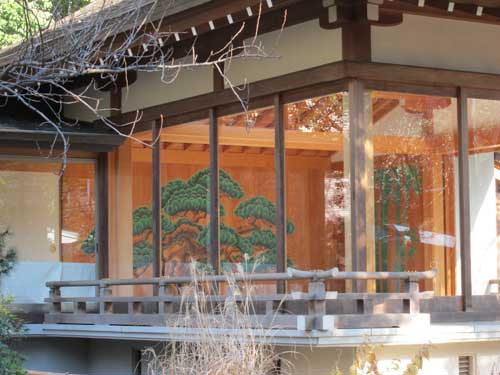
On a walk through Aoyama and Harajuku this winter, I entered Hatomori jinja, a beautiful green space with a shrine and and Noh theater.
 It was strange to be in an urban oasis of trees and greenery and see this glass encased theater decorated with an elaborate pine tree painting.
It was strange to be in an urban oasis of trees and greenery and see this glass encased theater decorated with an elaborate pine tree painting.
Is art civilizing nature? Or is nature sheltering art? I do not understand much about Noh theater but I love how the image of an idealized pine assumes a sacred and formal role in the performance.
Across from the Noh theater is the shrine itself. Because it is winter, there is a circle of rice straw you walk through in order to enter the shrine. I love how this shrine had visual signs about how to wash your hands, and the proper way to pray. Japanese can be very precise in providing step-by-step instructions.
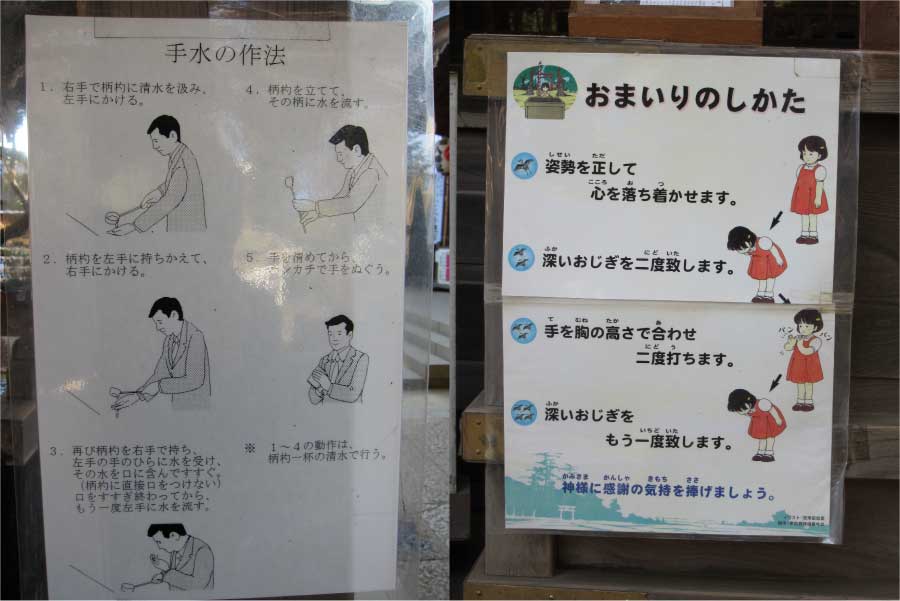
Aoyama is a mostly wealthy neighborhood, and includes a famous ginko lined street as well as the Crown Prince’s residence in Togu Gosho. There are many good-looking modern buildings, too. I was surprised to see this ruined old building.

Finally, heading into Harajuku, I saw an apartment building named Maison Harajuku covered in plants. I believe that it is a single vine originating from the right side of the front of the building. How long could it have taken for the vine to cover the building? What maintenance is required to keep it from swallowing the building?
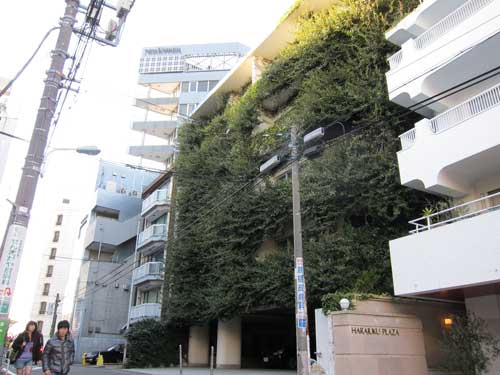
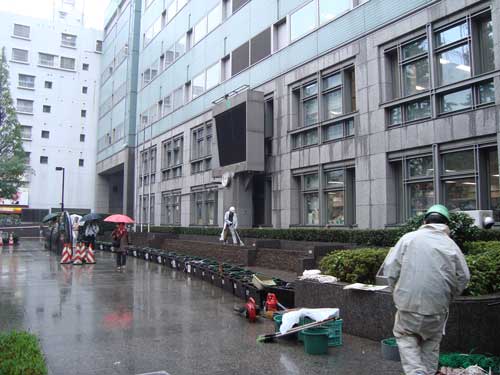
Last week, on October 7, I took a friend by the Suginami Ward office to see their giant green curtain. Unfortunately, the workers were in the final stages of removing it: sweeping up, saving the net for next year, cleaning the planter boxes (which last winter they filled with pansies), collecting the information signs.
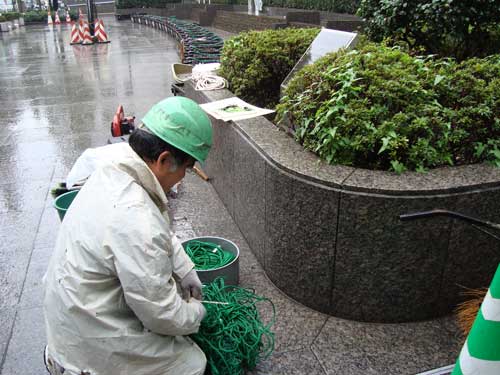
It seemed a little early, until the next day when I realized what chaos Typhoon #18 would have caused. Our balcony garden suffered some damage to our green curtain, which is a mere 2 meters by 4 meters. I can only imagine how the wind would pull on Suginami Ward office’s seven story green curtain, and deposit leaves and vines in all directions. I wonder if a typhoon had come in September, if they would have dismantled it beforehand.
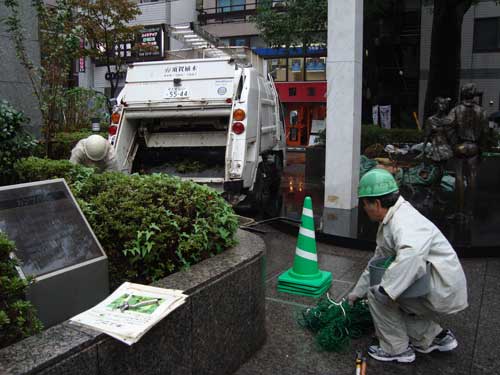
It’s sad to realize that fall has most definitely replaced summer. I wonder if the vines will be composted? Suginami is one of Tokyo’s few wards with residential composting, so I hope so!
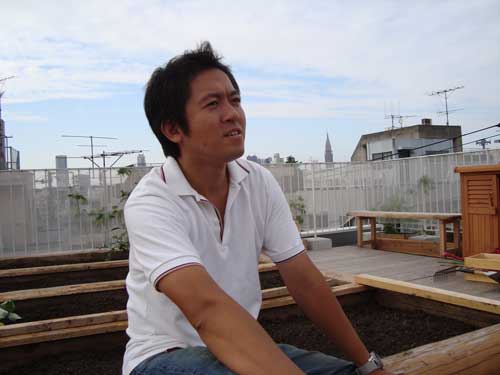
On the first of September, Iimura Kazuki (飯村一樹) opened Omotesando Farm (表参道彩園), a roof-top garden rental space in a central upscale commercial and residential district. He is offering sixteen small plots at rents ranging from $170 to $250 per month (15,750 to 23,100 yen). Although community gardens exist in outer neighborhoods of Tokyo, Omotesando Farm is only the second roof-top one in central Tokyo. The other is on top of the JR Ebisu station.
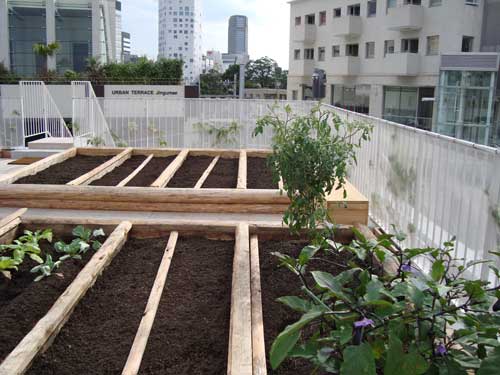
With stunning views of Shinjuku, Roppongi and Aoyama, the roof is located on a three story modern structure, next door to the Paul Smith boutique on a small back street. Because the roof is concrete, no structural changes were necessary. Iimura-san brought in special light-weight soil from a Chiba Research Center (Norin), and the same wood artisan Hirano who created Ginza Farm built the planters and deck here using untreated Japanese cedar (杉). Both are great examples of fine craftsmanship combining function, elegance, and avoidance of chemicals. On the roof perimeter, vines have been planted to cover the banister.
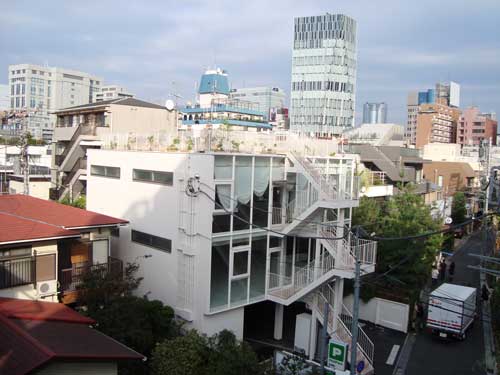
Iimura-san explained several surprises in starting this new urban farming concept. He was able to quickly rent all the plots, with many responding to ads on Yahoo Japan and all registering online. Iimura-san imagined that he would attract people who live nearby and families. However, these first customers are almost all young, many couples, and most are drawn by the proximity of Omotesando Farm to their work spaces. While visiting, I spoke briefly to an older customer who lives in Saitama, but is making Omotesando Farm part of his work day. He showed off his vegetable seedlings protected with plastic bottles from the birds.
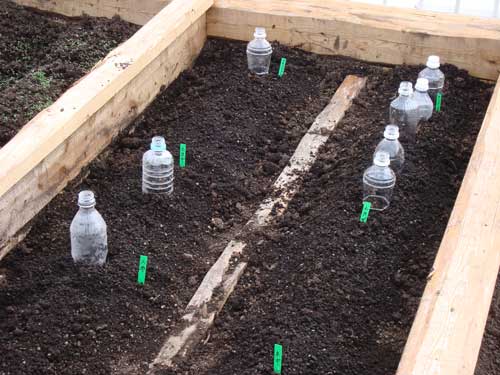
Iimura-san estimates that 70% of his customers are female, and that 75% are new to vegetable farming. Omotesando Farms is planning to provide a coaching system, using agricultural students and/or farmers visiting on the weekends. Although Omotesando Farms does not have the public access that the street-level Ginza Farm does, there has been tremendous media attention, including newspapers, television and radio. Even Japan’s top business newspaper, the Nikkei, has written a story about Omotesando Farm. Iimura-san thinks it is because this project combines “LOHAS” (a lifestyle of health and sustainability) with a green business idea that turns wasted space into a profitable business benefiting green entrepreneurs and property owners.
Iimura-san is already planning to open several more rental garden plots early next year, in Harajuku and Chuo-ku. I wish him luck in inspiring urban residents to grow their own food and creating an urban farming business.

Innovative government projects include Tokyo’s Suginami ward office building. In 2008 the municipal government in 2008 planted the world’s tallest “green curtain” to reduce carbon dioxide, lower energy costs, and demonstrate new green technology.

The green curtain covers the south wall of the main city offices, with support from a net nearly 29 meters in height, and a wall of vegetation consisting of fast-growing vines such as loofah, cucumber, gourd and morning glory. The vines are growing in small containers, with a moisture sensor that makes watering very efficient. During summer and fall, the offices are cooler by 4 degrees celsius.
This Tokyo ward-level project is an amazing demonstration of vertical urban gardening, but unfortunately little information is available online in English about this project.
UPDATE: There’s a fantastic 2010 blog about a Suginami resident creating a small green curtain. Wonderful photos document the progress, lots of information about plant types, and participation of 4 year old child. Very cool!